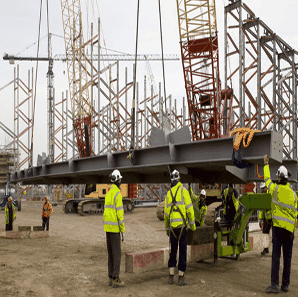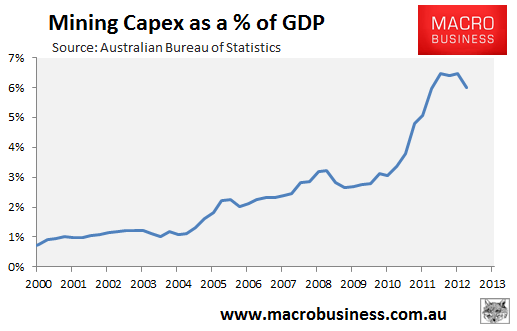
As noted by Houses & Holes today, Australia is fast approaching the mining investment cliff, with another group of economic consulants forecasting a quicker than expected slowdown in mining-related capital expenditures (capex).

With falling capex comes the prospect of lower GDP growth and jobs. The former can at least be partly offset by rising mining exports (albeit against falling prices), whereas the latter – rising unemployment and lower incomes – is the bigger risk facing the Australian economy, since the construction phase of mining projects is far more labour intensive than the completion (export) phase.
With the mining capex boom now unwinding, Australia needs to find ways to fill the void to both growth and jobs. With a bit of luck, increased housing-related construction will fill some of the hole. But it is unlikely to be anywhere enough, given the excessive land costs still dogging Australia’s various housing markets (pricing new homes above what many buyers can afford or are willing to pay), as well as the excessive planning taxes and red tape that are hindering an effective supply response.
Another effective option is to boost investment in productivity enhancing infrastructure – i.e. projects whose expected benefits far outweight their costs and whose cost of financing can be funded by the increased productivity (and therefore tax revenue) that they create, making the project’s debt “self liquidating”.
The infrastructure angle is one that I have pushed strongly throughout the year. But I am by no means alone, with a large number of commentators – from Michael Pascoe to Jessica Irvine – also pushing this barrow. Today, the Age’s Tim Colebatch has entered the fold with a sensible article arguing that increased infrastructure investment is neccessary to build a stronger economy:
Infrastructure needs to be at the heart of Australia’s economic policymaking. For 30 years, from the Fraser government on, we suffered an infrastructure drought, as governments economised on capital spending to allow them to get on top of debt and deficits. We now have a large infrastructure deficit – and we don’t want to pay the taxes needed to fix it.
That means it is crucial that we build only the projects that will deliver the biggest long-term return to the economy and the community. Build anything else and we are wasting money that would be better spent elsewhere…
From 1959 to 1977, the Bureau of Statistics estimates, infrastructure spending within Commonwealth and state budgets averaged 4.5 per cent of our gross domestic product. Then the Fraser government became obsessed with reducing the public sector borrowing it thought was ”crowding out” the private sector. Within a decade, under Coalition and Labor alike, budget sector infrastructure spending shrank to 3 per cent of GDP, where it has remained ever since, apart from the Rudd government’s school building phase.
At federal or state level, it is a foolish economy to scrimp on infrastructure when you have a population growing at 1.8 per cent a year. They don’t have to be mega-projects: consultant David Greig, of ACIL Allen points out that many smaller projects in Victoria return benefits four to 10 times their cost by reducing congestion…
Transport infrastructure matters. First, it can provide massive benefits to future users: think of the benefits later generations in Melbourne have enjoyed from the 19th-century investment in our rail network. Second, it can play a vital role in lifting Australia’s productivity growth: imagine the time you would save if your least-favourite level crossing were removed.
But third, at a time when Australia’s growth future is uncertain, bringing forward those productivity-enhancing road and rail projects is the ideal ”no regrets” insurance policy for the economy against a rapid slowdown of mining investment.
Both parties are painting themselves into a corner by trying to show they’re tough on tackling the deficit…
Ultimately, it’s not the deficit that matters. It’s the economy, stupid. Building more infrastructure, selected on merit, rail or road, is the best way to ensure the economy makes a soft landing as mining investment falls.
It’s hard to argue with Colebatch’s logic. The key factor determining whether infrastructure investment is ultimately successful in boosting productivity and living standards is to set-up a framework that ensures any such investment is well-targeted and based on rigorous cost-benefit analysis, rather than being politically expedient. What Australia needs to avoid at all costs are expensive ‘white elephants’ that are based on political motivations, do little to improve Australia’s productive capacity or living standards, and benefit only tiny segment of the population at the expense of the majority.
Done properly, however, well targeted infrastructure investment offers Australia the double dividend of supporting growth and jobs as the mining investment boom fades, whilst also expanding Australia’s productive base and improving living standards. As Colebatch says, Infrastructure needs to be at the heart of Australia’s economic policymaking.

